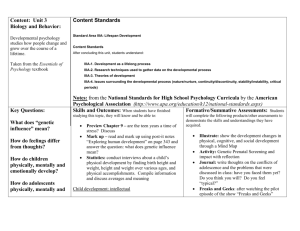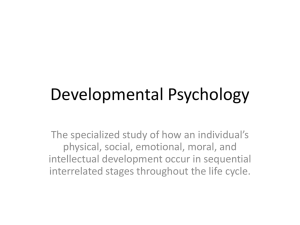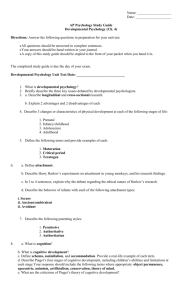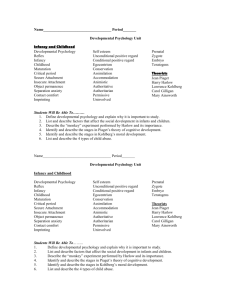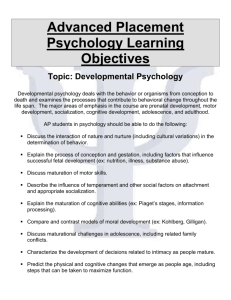Chapter 1: The Study of Human Development
advertisement
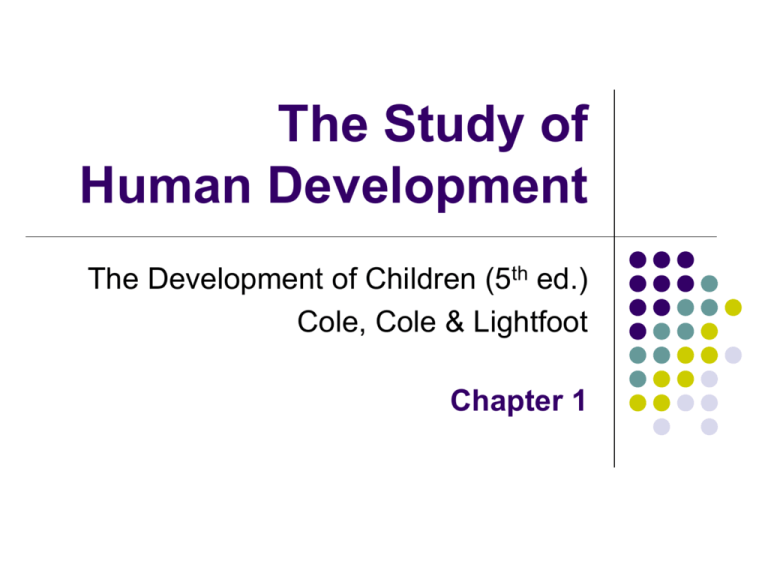
The Study of Human Development The Development of Children (5th ed.) Cole, Cole & Lightfoot Chapter 1 Basic Concepts Developmental psychology A study of physical, cognitive, and psychosocial changes that transpire throughout the course of human development Growth years Period from infancy through adolescence Study of Child Development Focus Physical changes Cognitive changes Psychosocial changes Aim Promote the healthy development of children Answer important questions… Intriguing Questions How are fetuses in the womb influenced by the events occurring in the outside world, and how do such influences shape their development? Can changes in diet and upbringing compensate for genetic abnormalities? In what ways is brain development affected by experience? Intriguing Questions What makes it possible for infants to acquire their native language so rapidly with no special training? When do children become aware that other people have thought processes of their own, and what makes this awareness possible? What leads to the marked differences in levels and forms of aggression between boys and girls early in childhood? Intriguing Questions Why do some children learn to read with little effort, while others require extensive help? What causes some children to be bullies? When do children begin to reason systematically, and what makes this form of thought possible? Is parent-child conflict a necessary part of adolescence? Overview of the Journey Early Beginnings of Modern Developmental Psychology Central Questions of Developmental Psychology Developmental Psychology as a Discipline Early Beginnings of Modern Developmental Psychology Jean-Marc Itard and Victor, the Wild Boy of Aveyron Industrial Revolution and Research into Child Labor Conditions Charles Darwin’s The Origin of Species Victor, The Wild Boy France (province of Aveyron), 1800, ~age 12 Jean-Marc Itard (physician) To test the theory that social environment shapes a child’s development Abandoned the experiment after 5 years Victor never learned to speak or interact normally Maybe as a result of autism or social isolation A beginning point for developmental psychology because Itard was among first to go beyond mere speculation to conduct experiments to test his ideas Child Labor Conditions England (1833): Factory Inquiries Committee decided that 12 hours was an acceptable workday for children Others disagreed: Believed that 10-hour workday preferable, with remaining 2 hours devoted to religious/moral education Research results: Children who worked in textile mills were shorter and weighed less than local nonworking children The Origin of Species (1859) Rather than viewing children merely are imperfect adults, not to be seen or heard Children came to be viewed as scientifically interesting because their behavior might provide clues to ways in which humans are related to other species Ontogeny recapitulates phylogeny Phylogeny: The evolutionary history of a species Ontogeny: Development of an individual organism over its lifetime Distinctive Differences… Homo sapiens Develops a unique environment consisting of artifacts (e.g., tools, clothing, words), knowledge (e.g., how to construct and use artifacts), beliefs, and values culture Shapes and transmits culture to succeeding generations largely through language Seeks understanding of transcendental dimensions Central Questions of Developmental Psychology Continuity Sources of Development Plasticity Individual Differences The Question of Continuity Is the process of development gradual and continuous (primarily in the form of quantitative changes), or is it marked by abrupt, stagelike discontinuities (primarily in terms of qualitative changes)? Continuous/ Quantitative vs. Discontinuous/ Qualitative Developmental Stages Developmental Stages 1. 2. 3. 4. Distinguished by qualitative changes (e.g., crawling walking) Marked by simultaneous changes in many, if not all, aspects of a child’s behavior (e.g., enhanced mobility new child-caregiver relations) Characterized by rapid changes (e.g., transition from crawling walking in < 90 days) Behavioral and physical changes merge to form a coherent pattern (e.g., walking accompanied by pointing, ability to follow another’s gaze, first words, new child-caregiver relations) List three ways in which the person you were at the age of 5 differed from the person you were at the age of 15. Label those differences as either qualitative or quantitative. The Question of Developmental Sources How do nature (biology) and nurture (environment) interact to produce development? Philosophical Foundations Nature of man John Locke: Tabula rasa (neutral) Jean-Jacques Rousseu (Emile): Innately good Jonathan Swift (“odious vermin”): Intrinsically evil Nature vs. Nurture Gender and mathematics: A case in point… Nature (inherited biological predispositions) Advise girls to take less challenging math courses, use different standards on quantitative sections of standardized tests Nurture (influence of the social and cultural environment on the individual) Encourage girls to take more challenging math courses, hold out societal models of women in math and science List two major ways in which you are like your best friend and two major ways in which the two of you are different. What causal factors do you think are primarily responsible for these similarities and differences? The Question of Plasticity To what degree, and under what conditions, is development open to change and intervention? Are there critical or sensitive periods? “No” & “Yes” Konrad Lorenz & Goslings The Question of Individual Differences How do people come to have stable individual characteristics that differentiate them from one another? Individual Differences 1. What makes individuals different from each other? 2. Nature vs. nurture: fussy infant, obese child To what extent are individual characteristics stable over time? Is the temperament of a baby an indicator of its personality as an adult? Case of children who remain in an orphanage vs. adopted (p. 13) – What might be the implications? Developmental Psychology as a Discipline Criteria of Scientific Description Methods of Data Collection Research Designs The Role of Theory Criteria of Scientific Description Objectivity Not distorted by preconceptions Reliability Test-retest & inter-rater consistency Validity Actually reflects what is being studied Replicability Similar findings by other researchers Methods of Data Collection Self-Reports Interviews, questionnaires, behavioral checklists Problems: Inaccuracies, may not understand questions, selective memory Naturalistic Observations Baby biographies (e.g., Darwin, Piaget), ecological studies (e.g., developmental niche)… Problems: Difficult to maintain objectivity, observer may affect situation The Ecological Approach Methods of Data Collection Experimental Methods Experimental & control group Problems: Correlation vs. causation, artificiality of context Clinical Interview Methods Tailor question depending on answer to previous question (e.g., Freud, Piaget) Problems: Difficult to compare across individuals, relies heavily on verbal expression Research Designs What is one question you have about the development of children? How do you think one might go about finding the answer? Gesell & Freud Watson & Skinner Endogenous factors Exogenous factors Piaget Active shaping Vygotsky Mediated by culture The Role of Big Theory Bio-Social-Behavioral Shift A transition point in development during which a convergence of biological, social, and behavioral changes occurs to cause distinctively new forms of child functioning. Prominent Shifts & Subsequent Periods Shift Point Conception Birth 2 ½ months 7-9 months 24-30 months 5-7 years 11-12 years 19-21 years Developmental Period Prenatal period Early infancy Middle infancy Late infancy Early childhood Middle childhood Adolescence Adulthood
